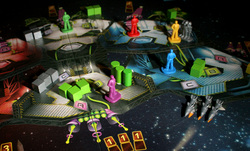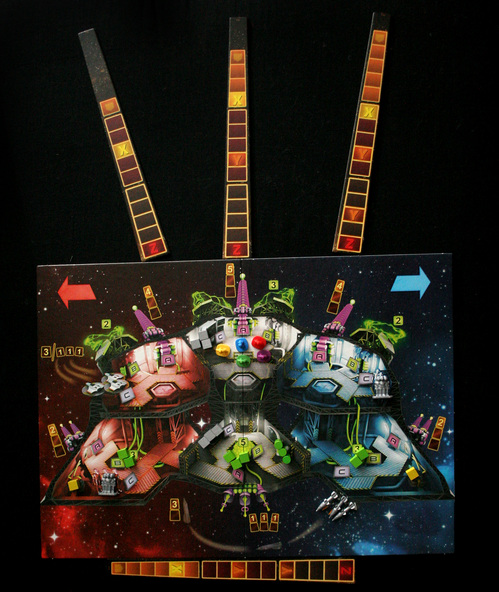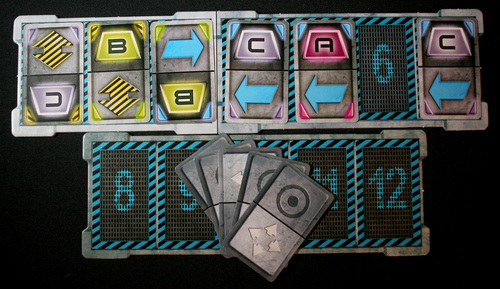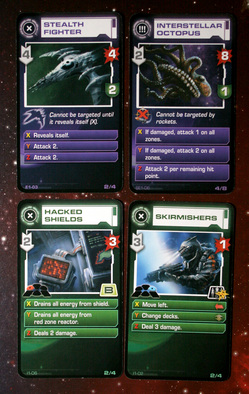Space Alert: 10 minutes of frantic--and fun--teamwork

Mike Hulsebus | Contributor
Vlaada Chvátil's game, Space Alert, has perhaps one of the best examples of teamwork in a board game that I have played. The game is played in real time as players try to hectically and simultaneously plan out their turns. No one player can dominate the game. There's not even enough time to plan out your own actions let alone someone else's, so you have to rely on your crewmates in order to come out alive.
Space Alert is a cooperative game that seems to want its players to lose. You and your crew are sent out on a suicide mission in a ship called The Sitting Duck and from the moment you arrive on location, your ship is besieged with enemy ships, boarders and mechanical failures. Victory doesn't require that you torpedo an exhaust port or take out an alien base: You only have to survive for 10 minutes until your ship maps the star system and jumps away. Thematically, it makes for an interesting scenario, but how does it play? Does it feel like nerve-wracking work or is it fun?
In order to understand how this game works, let's take a look at the board.

Mike Hulsebus | Contributor
Enemy ships appear on the three tracks shown above the ship and each zone's guns can only fire on ships coming from its side of the ship. The green cubes represent energy and are required to charge the shields and fire the guns. Energy has to be routed from the main reactor in the lower white zone to the other side reactors. The lower track represents the progress of internal threats that range from people boarding the ship to the ship's systems malfunctioning.
Players schedule their actions on the numbered tracks in front of them by playing cards from their hands. Each card can be used for either movement or an action, depending on which end of the card is facing up when it is placed on the track. Cards are normally placed facedown, but in the photo below they are face up for example's sake. Here a player has locked in his first phase actions (go below deck, use a fuel canister to resupply energy, go right) and is working on his second phase actions. Once the mission indicates that a phase has ended, he will add the five cards sitting on phase three to his hand and plan out his final actions.

Mike Hulsebus | Contributor

A sampling of threats from the game's different decks.
Mike Hulsebus | Contributor
A game of Space Alert begins by playing a mission track from the game's CD (mp3s are also available on their website if you prefer to use someone's phone to play the audio). The mission track lets players know what threats are attacking the ship with announcements like “Alert: Time T+3. Serious threat. Zone white,” which means to draw a random serious threat from the serious threat deck and to place it on the middle track. It will enter at time 3 while players plan out their actions to man the guns, pull energy to shields, and resupply the reactor. More threats will appear and players will have to try to deal with those while making sure that the asteroid flying toward the ship doesn't get forgotten in the action.
It's frantic and chaotic, which is what most detractors of the game don't like about it, but that's what I like most about the game. There is so much happening and so many things that happen at once that it's a challenge to work together well enough that the guns stay firing and the shields stay up. I can understand why people wouldn't like Space Alert. It's certainly not for everyone.
But I think the challenge is what makes the game fun. Yes, if one person messes up, it can ruin everything when he thought he was moving to the right side of the ship to fire and actually went left and fired all of your energy away while a space octopus sits on the other side of the ship. Yes, you have to deal with having a ticking clock telling you how much time you have left from time to time. Yes, it can be tricky to make sure you get in the right room at the right time to combat moving internal threats.
But this is what makes the game hard and this is what makes the game so satisfying to win. There are no dice that can roll well on to save your crew. It's all about how well you can communicate and how well you can manage your resources as a team. Without the time limitation, the game would feel like a puzzle, which isn't what I'm looking for in a group game. With the time limitation, the game is action-packed, thrilling and satisfying.
A final note: The game plays best with four or five players but also includes a solo variant that I've played a few times and enjoyed. It plays differently and has different rules for choosing actions. But unlike other games I own that offer solo play, Space Alert is actually decently fun to play yourself even though it's designed for a larger group.
In all, I think Space Alert is a great game that, if you don't mind the element of being under time pressure, I think will appeal to a lot of people. Because the game is made for four or five people, you'll want to make sure you have people to play it with before you go out and buy it since that is a very specific number of people to get together. I look forward to logging more plays of Space Alert and am curious to see if our crew can get good enough to take on the higher difficulties that the game offers.
Mike Hulsebus can now officially say he has played a game that involves both battling space amoebae and keeping a computer system's screensaver from coming on. Data transfers can be sent to mikehulsebus@gmail.com

